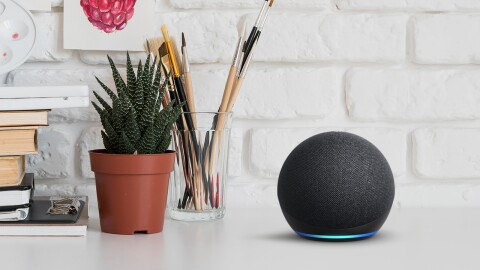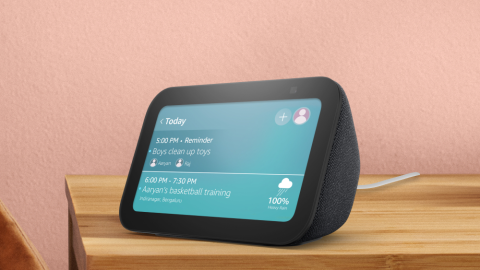As the usage of smart home has increased across Indian households, almost 92% users say that voice-control has made it convenient for them to set up a smart home. This insight came up in a study conducted by Techarc for Amazon India, to understand smart home adoption and usage trends in India. The study collected inputs from over 1200 smart home users, residing across metro and non-metro cities.
92% of the smart home users responded that voice-control has made it convenient to set up a smart home.
Faisal Kawoosa, Founder and Chief Analyst, Techarc, highlighting the key inferences of the study said, “Among factors like increase in penetration of fixed broadband and need for automation in homes due to Covid-19 pandemic, the convenience of interacting with home appliances through voice has emerged as an essential factor driving smart home adoption. A smart home environment is effectively useful when all members in the family can interact, command and control appliances without the need to upskill or learn”.
Key inferences from the smart home study
More than 90% of users have purchased their first smart home device in the last two years.
- Mass adoption of smart home is a recent phenomenon: The smart home adoption in India is moving towards mainstream with more homes coming into the purview. Of all the study respondents, more than 90% have purchased their first smart home device in the last two years. While most of the high-value devices like TVs are purchased off-line, a majority on smart home appliances are purchased on online/ e-commerce websites.
- Adoption of smart home is driven by the urge to try new technology: In general, users across metro & non-metro cities rank ‘to try new technology’ as a primary reason for adoption of smart home devices. However, when we look at different device categories, the subsequent reasons to purchase show an interesting trend. Smart speakers, smart TVs and smart lights are purchased more ‘to try new technology’; smart AC and washing machines because of their ‘energy-efficiency’; smart cameras and IR blasters for their ‘connectivity/ automation’; and smart ovens, smart vacuum, and smart air purifier because they ‘came across a good deal or discount.’
Recommendations from friends & family, advertisements (TV and online ads), and social media are the top three sources of information about smart home.
- Family and Friends are the most popular sources of information about smart devices: Smart home users in India are most influenced by family and friends to know more about new devices, their features, and reviews. This medium of discovery is closely followed by advertisements on TV/ online, and social media mentions.
- Smart home utility has expanded from entertainment to productivity: Smart TVs (73%) and smart speakers (45%) are the top two devices in a typical smart home configuration. However, the adoption of other devices that add to convenience, and productivity has also started to pick up. These include, washing machines, vacuum cleaners, security solutions and refrigerators.
Besides smart speakers, smart TV (81%), smart lights (56%) and smart ACs (55%) are the top 3 home appliances that are mostly operated using voice.”
- ‘Smartisation’ is inevitable for creating a sustainable brand: Many incumbent brands manufacturing home appliances such as TVs, fridge and washing machines have been able to maintain their position as the preferred choice for customers because of ‘smartisation’ of their range of appliances. Newer brands providing smart home appliances have an edge in categories such as smart lights, smart security, smart plugs and IR blasters because of their competitive pricing and features.
Key inference from the qualitative study
- Smart homes give peace of mind and make technology inclusive. Many users install smart home devices for convenience, comfort and to monitor safety- security of their loved ones, including parents and children. Voice assistants enable all family members to engage with smart devices without any restrictions.
“It was a task to walk up to the switch board every time to operate the lights in my room. My kids installed Smart Lights which magically works at my command. I no longer call my grandkids in the middle of the night to help me walk up to the switch board when I have to use the restroom”, shares a 75-year-old male from Bangalore.
“We no longer worry about leaving our kids at home when we go out for work. Smart security appliances have made monitoring and safety of our homes easier and trustworthy”, shares a working couple from Patna.
“There are thousands of smart home devices compatible with Alexa across categories like bulbs, plugs, locks, cameras, ceiling fans, TVs, air conditioners, air purifiers, etc. ranging from INR 500 to INR 1,50,000. The wide selection from top brands in India have made it convenient for customers to get started on their smart home journey and experience the magic of hands-free control with Alexa”, said Parag Gupta, Director and Country Manager for Amazon Devices, India.
About the Study: The study was conducted by way of a survey among 1200 smart home users, equally split between metro and non-metro cities. A qualitative study (group interaction) was done with 10 smart home user families within these 1200 respondents to understand deeper insights about the factors driving adoption, user journey and the role of voice in the smart home ecosystem. For the study, 13 smart home devices were identified which comprise of a typical configuration of a smart home in India. Respondents having 3 or more of the identified 13 smart home devices, were considered as smart home users for the purpose of this study.
List of smart home devices: Smart Speaker, Smart TV, Smart AC, Smart Light/Bulb, Smart Fridge, Smart Washing Machine, Smart Oven, Smart Vacuum, Smart Water Purifier, Smart Air Purifier, Smart Security (Door Lock, Camera), Smart Plug, and Smart IR Blaster.


To view the detailed report, click here.











